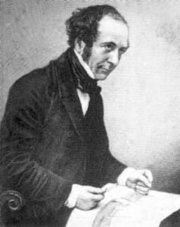John Scott Russell
|
|
John Scott Russell (May 9 1808- 8 June 1882) was a naval engineer who built The Great Eastern in collaboration with Isambard Kingdom Brunel, and made the discovery that gave birth to the modern study of solitons.
| Contents |
Early Life
Russell was born in Glasgow, Scotland. He graduated from Glasgow University in 1825, and moved on to Edinburgh University where he taught mathematics and natural philosophy.
The wave of translation
In 1834, while conducting experiments to determine the most efficient design for canal boats, he discovered a phenomenon that he described as the wave of translation. In fluid dynamics the wave is now called a Russell solitary wave. The discovery is described here in his own words:
"I was observing the motion of a boat which was rapidly drawn along a narrow channel by a pair of horses, when the boat suddenly stopped - not so the mass of water in the channel which it had put in motion; it accumulated round the prow of the vessel in a state of violent agitation, then suddenly leaving it behind, rolled forward with great velocity, assuming the form of a large solitary elevation, a rounded, smooth and well-defined heap of water, which continued its course along the channel apparently without change of form or diminution of speed. I followed it on horseback, and overtook it still rolling on at a rate of some eight or nine miles an hour, preserving its original figure some thirty feet long and a foot to a foot and a half in height. Its height gradually diminished, and after a chase of one or two miles I lost it in the windings of the channel. Such, in the month of August 1834, was my first chance interview with that singular and beautiful phenomenon which I have called the Wave of Translation".
- J. Scott Russell. Report on waves, Fourteenth meeting of the British Association for the Advancement of Science, 1844.
Russell spent some time making practical and theoretical investigations of these waves, he built wave tanks at his home and noticed some key properties:
- The waves are stable, and can travel over very large distances (normal waves would tend to either flatten out, or steepen and topple over)
- The speed depends on the size of the wave, and its width on the depth of water.
- Unlike normal waves they'll never merge - so a small wave is overtaken by a large one, rather than the two combining.
- If a wave is too big for the depth of water, it splits into two, one big and one small.
Russell's experimental work seemed at contrast with the Newton and Bernoulli's theories of hydrodynamics. His contemporaries spent some time attempting to extend the theory but it would take until 1895 before Korteweg and de Vries provided the theoretical explanation (D.J. Korteweg and G. de Vries; On the Change of Form of Long Waves advancing in a Rectangular Canal and on a New Type of Long Sationary Waves; Philosophical Magazine, 5th series, 36, 1895, pp. 422--443).
It was not until the 1960s and the advent of modern computers that the significance of Russell's discovery in physics, electronics, biology and especially fibre optics started to become understood, leading to the modern theory of solitons.
Ship building
Russell moved to London in 1844, and organised the Royal Commission for the Great Exhibition of 1851. He worked on the design of yachts, boats, barges and ships, and he became a director of a ship-building company.
He was held in high regard by Isambard Kingdom Brunel who made him a partner in his project to build the Great Eastern. At its time, this was to be the largest moveable object man had ever created. The project was plagued with a number of problems - Russell was in financial difficulties and the two men disagreed on a number of aspects of the design and construction of the ship. The Great Eastern was eventually launched in 1858.
Russell was a better scientist than a businessman and his reputation never fully recovered from his financial irregularities and disputes.
Miscellany
Russell made the first experimental study of the Doppler effect.
In 1995, the aqueduct which carries the Union Canal over the Edinburgh Bypass (A720) was named the Scott Russell Aqueduct in his memory.de:John Scott Russell fr:John Scott Russell

